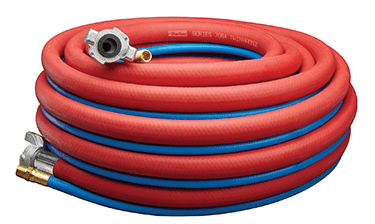
A new hose and new awareness for a hazardous issue, respirable crystalline silica:
In an effort to protect against worker inhalation of harmful crystalline silica, new regulations have been set by OSHA. Jackhammer and other breaker tool applications are covered by the construction industry compliance regulation 29 CFR 1926.1153 with a start date of September 23, 2017. A wet suppression method is considered an effective tactic within a larger protective plan for a safer workplace. The wet suppression method involves spraying a constant flow of water at the breaker tool as it cuts through dust causing media.
Rather than having a jackhammer operator as well as a water sprayer operator, an air and water spray system can be devised using a jackhammer hose paired with a water supply hose. Hoses can be paired together using heat shrink tape or zip ties, or a more permanent and professional solution is now available from Parker Industrial Hose. Twinhammer™ Jackhammer hose assemblies bond a 3/4 inch red air hose and a 3/8 inch blue water supply line. Both hoses are 300 PSI rated* domestically produced EPDM rubber, with factory crimped connections. The air hose has crimped universal / Chicago couplings and the water hose has crimped brass 3/8 inch male NPT couplings.
Whether you choose to incorporate Twinhammer assemblies, retrofit your current hose assemblies, or use a two person system of sprayer and breaker, choose to safety and comply with these new regulations for a healthy workforce.
To learn more about OSHA compliance to 29 CFR 1926.1153 visit the link below:
OSHA’s Crystalline Silica Rule: Construction
OSHA’s Crystalline Silica Rule: General Industry and Maritime
Twinhammer is a registered trademark of Parker Industrial Hose, a division of Parker Hannifin
OSHA (Occupational Safety and Health Administration) is a division of the US Department of Labor, all rights reserved
OSHA links and information are provided for informational and educational use only, contact your regulating agencies directly to confirm accuracy and compliance